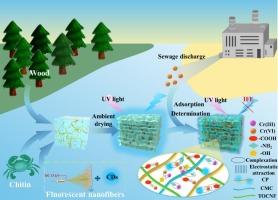环境干燥生物质“砖-砂浆-粘结剂”结构三维多孔气凝胶测定及吸附Cr(VI)
IF 13.2
1区 工程技术
Q1 ENGINEERING, CHEMICAL
引用次数: 0
摘要
生物质气凝胶在治理水污染方面具有广阔的应用前景。然而,传统的制备方法受到高能耗的限制,偏离了材料用于环境修复的初衷。本文首次提出了一种环境干燥条件下制备的“砖-砂浆-粘结剂”结构生物质气凝胶,用于测定和吸附Cr(VI)。该生物质气凝胶由接枝CDs的聚丙烯腈(PAN)纳米纤维作为“砖”,柔性2,2,6,6 -四甲基-1-胡椒酰氧基氧化纤维素纤维和羧甲基壳聚糖作为“砂浆”,以及(4,6 -二甲氧基[1.3.5]三嗪-2-酰基)-4-甲基氯化铵水合物(DMTMM)作为“粘合剂”组成。TOCNFs和CMC的凝胶和交联是由DMTMM引发的。该方法制备的固体水凝胶在环境挥发过程中能够抵抗毛细力,经冷冻、溶剂解冻交换、室温干燥后成为气凝胶。将CDs接枝到PAN纳米纤维上,不仅可以提供荧光信号和吸附位点,而且可以防止CDs脱落。同时,在气凝胶中引入纳米纤维,使生物质气凝胶的机械强度和弹性提高了6倍(从17.60 KPa提高到98.85 KPa)。环境干燥生物质气凝胶对Cr(VI)具有良好的灵敏度和选择性,检测限低至1.12 μM,线性范围为5 ~ 50 μM。在室温和pH = 2条件下,对Cr(VI)的吸附量为166.25 mg/g,符合拟二级吸附动力学和Langmuir模型。阐明了生物质气凝胶检测和吸附Cr(VI)的机理。本工作提出了一种环保、可持续、低能耗的构建功能生物质气凝胶的方法,该方法可用于检测和吸附重金属离子,从而扩大了环境干燥气凝胶在环境保护方面的应用。本文章由计算机程序翻译,如有差异,请以英文原文为准。

Ambient-dried biomass 3D porous aerogel with “brick-mortar-binder” structure for the determination and adsorption of Cr(VI)
Biomass aerogel has broad application prospects in eradicating water pollution. However, conventional preparation methods are limited by high energy consumption, which deviates from the original intention of materials for environmental remediation. In this work, a biomass aerogel with “brick–mortar-binder” structure prepared at ambient drying is proposed firstly for the determination and adsorption of Cr(VI). This biomass aerogel consists of polyacrylonitrile (PAN) nanofibers grafted with CDs serving as “brick”, flexible 2, 2, 6, 6-tetramethyl-1-piperidinyloxy −oxidized cellulose fibers and carboxymethyl chitosan as “mortar”, and (4, 6-dimethoxy[1.3.5]triazin-2-yl)-4-methylmorpholinium chloride hydrate (DMTMM) functioning as “binder”. The gel and crosslinking of TOCNFs and CMC are initiated by DMTMM. This method produces solid hydrogels that can resist capillary force during environmental volatilization, and become aerogels through freezing, solvent thawing and exchange, and drying at room temperature. Grafting CDs onto electrospun PAN nanofibers not only provides fluorescent signal and adsorption sites, but also prevents CDs from falling off. Meanwhile, nanofibers are introduced into aerogel, which enhances mechanical strength and boosts elasticity of biomass aerogel by 6 times (from 17.60 to 98.85 KPa). This ambient-dried biomass aerogel shows excellent sensitivity and selectivity to Cr(VI), possessing a detection limit as low as 1.12 μM and a linear range of 5–50 μM. It also has an adsorption capacity of 166.25 mg/g for Cr(VI) at room temperature and pH of 2, conforming to pseudo-second-order adsorption kinetics and Langmuir models. The mechanism of detecting and adsorbing Cr(VI) by biomass aerogel is clarified. This work presents an environmentally friendly, sustainable and low-energy method for constructing functional biomass aerogels that can be utilized to detect and adsorb heavy metal ions, thereby expanding the application of ambient-dried aerogels in environmental protection.
求助全文
通过发布文献求助,成功后即可免费获取论文全文。
去求助
来源期刊

Chemical Engineering Journal
工程技术-工程:化工
CiteScore
21.70
自引率
9.30%
发文量
6781
审稿时长
2.4 months
期刊介绍:
The Chemical Engineering Journal is an international research journal that invites contributions of original and novel fundamental research. It aims to provide an international platform for presenting original fundamental research, interpretative reviews, and discussions on new developments in chemical engineering. The journal welcomes papers that describe novel theory and its practical application, as well as those that demonstrate the transfer of techniques from other disciplines. It also welcomes reports on carefully conducted experimental work that is soundly interpreted. The main focus of the journal is on original and rigorous research results that have broad significance. The Catalysis section within the Chemical Engineering Journal focuses specifically on Experimental and Theoretical studies in the fields of heterogeneous catalysis, molecular catalysis, and biocatalysis. These studies have industrial impact on various sectors such as chemicals, energy, materials, foods, healthcare, and environmental protection.
 求助内容:
求助内容: 应助结果提醒方式:
应助结果提醒方式:


